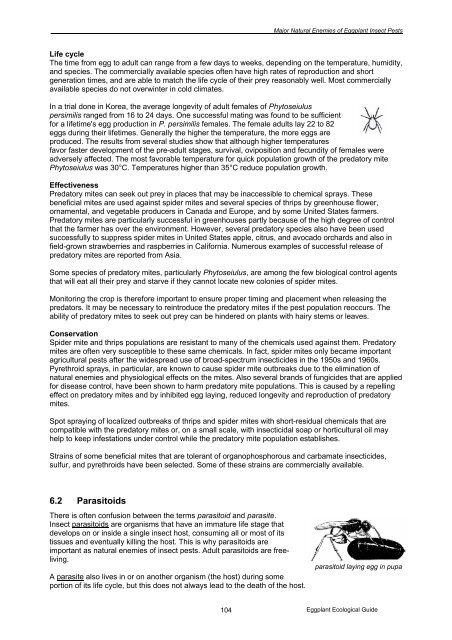Eggplant Integrated Pest Management AN ECOLOGICAL GUIDE
Eggplant Integrated Pest Management AN ECOLOGICAL GUIDE
Eggplant Integrated Pest Management AN ECOLOGICAL GUIDE
Create successful ePaper yourself
Turn your PDF publications into a flip-book with our unique Google optimized e-Paper software.
__________________________________________________________________Major Natural Enemies of <strong>Eggplant</strong> Insect <strong>Pest</strong>sLife cycleThe time from egg to adult can range from a few days to weeks, depending on the temperature, humidity,and species. The commercially available species often have high rates of reproduction and shortgeneration times, and are able to match the life cycle of their prey reasonably well. Most commerciallyavailable species do not overwinter in cold climates.In a trial done in Korea, the average longevity of adult females of Phytoseiuluspersimilis ranged from 16 to 24 days. One successful mating was found to be sufficientfor a lifetime's egg production in P. persimilis females. The female adults lay 22 to 82eggs during their lifetimes. Generally the higher the temperature, the more eggs areproduced. The results from several studies show that although higher temperaturesfavor faster development of the pre-adult stages, survival, oviposition and fecundity of females wereadversely affected. The most favorable temperature for quick population growth of the predatory mitePhytoseiulus was 30°C. Temperatures higher than 35°C reduce population growth.EffectivenessPredatory mites can seek out prey in places that may be inaccessible to chemical sprays. Thesebeneficial mites are used against spider mites and several species of thrips by greenhouse flower,ornamental, and vegetable producers in Canada and Europe, and by some United States farmers.Predatory mites are particularly successful in greenhouses partly because of the high degree of controlthat the farmer has over the environment. However, several predatory species also have been usedsuccessfully to suppress spider mites in United States apple, citrus, and avocado orchards and also infield-grown strawberries and raspberries in California. Numerous examples of successful release ofpredatory mites are reported from Asia.Some species of predatory mites, particularly Phytoseiulus, are among the few biological control agentsthat will eat all their prey and starve if they cannot locate new colonies of spider mites.Monitoring the crop is therefore important to ensure proper timing and placement when releasing thepredators. It may be necessary to reintroduce the predatory mites if the pest population reoccurs. Theability of predatory mites to seek out prey can be hindered on plants with hairy stems or leaves.ConservationSpider mite and thrips populations are resistant to many of the chemicals used against them. Predatorymites are often very susceptible to these same chemicals. In fact, spider mites only became importantagricultural pests after the widespread use of broad-spectrum insecticides in the 1950s and 1960s.Pyrethroid sprays, in particular, are known to cause spider mite outbreaks due to the elimination ofnatural enemies and physiological effects on the mites. Also several brands of fungicides that are appliedfor disease control, have been shown to harm predatory mite populations. This is caused by a repellingeffect on predatory mites and by inhibited egg laying, reduced longevity and reproduction of predatorymites.Spot spraying of localized outbreaks of thrips and spider mites with short-residual chemicals that arecompatible with the predatory mites or, on a small scale, with insecticidal soap or horticultural oil mayhelp to keep infestations under control while the predatory mite population establishes.Strains of some beneficial mites that are tolerant of organophosphorous and carbamate insecticides,sulfur, and pyrethroids have been selected. Some of these strains are commercially available.6.2 ParasitoidsThere is often confusion between the terms parasitoid and parasite.Insect parasitoids are organisms that have an immature life stage thatdevelops on or inside a single insect host, consuming all or most of itstissues and eventually killing the host. This is why parasitoids areimportant as natural enemies of insect pests. Adult parasitoids are freeliving.A parasite also lives in or on another organism (the host) during someportion of its life cycle, but this does not always lead to the death of the host.parasitoid laying egg in pupa104<strong>Eggplant</strong> Ecological Guide




![Section 4 [ PDF file, 252 KB] - The Field Alliance](https://img.yumpu.com/51387260/1/158x260/section-4-pdf-file-252-kb-the-field-alliance.jpg?quality=85)











